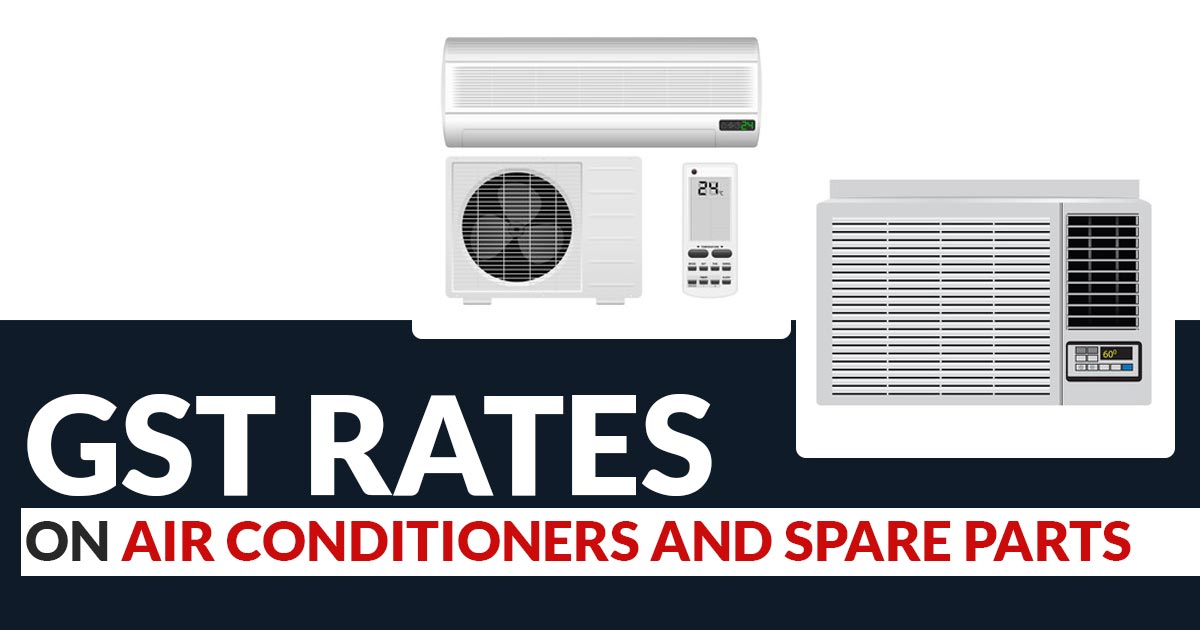
When the Goods and Services Tax (GST) was introduced, many electronic items saw higher tax rates. For example, air conditioners and large-screen TVs were taxed at 28%. However, following a recent GST Council decision, this rate has been reduced to 18%, effective September 22, 2025.
Why Did the Price of Air Conditioners Change Because of GST?
Earlier, the two major taxes on consumer durables were VAT and excise duty, with a combined rate of 23%–27% depending on the state. Under GST, air conditioners initially attracted 28%, leading firms to pass on the additional tax burden to consumers and increasing prices by 1%–5%.
However, following the 56th GST Council Meeting, the GST rate on air conditioners has been reduced to 18%, aligning them with the standard slab and offering relief to buyers. A cost comparison before and after GST is mentioned below:
| Particulars | Pre-GST (Rs.) | Post-GST (Rs.) |
|---|---|---|
| Cost of Manufacturing | 60,000 | 60,000 |
| Excise Duty at 12.5% | 7,500 | – |
| Production Cost | 67,500 | 60,000 |
| Transportation etc. | 5,000 | 5,000 |
| Value Addition | 5,000 | 5,000 |
| VAT at 14%*/ GST | 10,850 | 12,600 |
| Product Cost | 88,350 | 82,600 |
Subjected to GST on Air Conditioners
Almost all electronic goods attract Goods and Services Tax. After the 56th Council Meeting, the tax slab structure has been simplified to 0%, 5%, 18%, and 40% (for luxury/sin goods). Fundamental goods are levied at 5%, while the standard rate is 18%.
Air conditioners, earlier identified as luxury items and taxed at 28%, have now been obtained under the 18% GST slab. With increasing temperatures and varying climatic circumstances, air conditioners are no prolonged regarded morally as a luxury but are increasingly noticed as a condition.
What is the Supply Value for Calculating the GST on Air Conditioners?
Supply counts as a taxable event beneath GST. The supply comprises all types of sales, exchanges, transfers, rentals, leases, and disposals.
Value of Supply = Transaction Value
The value of the transaction is the cost furnished for the supply or services of the goods. Towards the concern of the sale of air conditioners, the supplier of air conditioners used to furnish the installation services in the majority of cases.
Hence, both supplies of air conditioners, along with the installation, are naturally bundled and provided with each other in the ordinary course of business. Hence the same poses a composite supply. The principal supply of air conditioners and their installation charges are coincidental. Value of supply = sale value + installation charges.
GST Rates on Air Conditioners with HSN Codes
18% is the GST rate on air conditioners. They come beneath chapter 8415.
| HSN code | Description |
|---|---|
| 8415 | An air conditioner with a motor fan for changing temperature and humidity. |
| 841583 | Not incorporating a refrigerating unit |
| 84158310 | Split air conditioner with 2 tonnes and above, and not incorporating a refrigerating unit. |
| 84158390 | Not incorporating a refrigerating unit: Other |
ITC Availability Upon Air Conditioners and Reversal
Beneath GST, every enrolled individual is qualified to avail of the Input Tax Credit on buying the goods or services that are to be utilised for business purposes. However, section 17(5) limits input tax credit on the goods or services obtained by the taxable individual towards the construction of the immovable property, excluding the plant and machinery on his part for the utilisation to move the business ahead.
Now, immovable property is that which is defined under Section 3(26) of the General Clauses Act, 1897 states that immovable property is said to be the “things attached to the earth or permanently attached to the walls and building”. But the air conditioners are attached to the walls; they could be removed and installed at any other place. It does not come under the immovable property.
A centralised AC system is acknowledged as plant and machinery and not an immovable property; therefore, restrictions u/s 17(5) must not apply. But the same must be ensured that the air conditioner cost must be separately booked as plant and machinery, and does not include the cost of building.
Moreover, when the AC has been installed in the office or factory for the purpose of business, ITC would be available. But when the supply consists of taxable and exempt goods, then the ITC reversal must be performed under Rule 42 and Rule 43 of the CGST Rules.
GST Concern on the Air Conditioner Import
The government has retained a high import duty on air conditioners to enhance the sale of local goods. The rise in import duties has the purpose of discouraging Indian enterprises from importing components from outside India, rather than substituting them with goods made in India.
Exemptions Available, if Any
At the present time, there are no exemptions available under GST upon the sale of air conditioners.
How do Air Conditioner Prices Get Impacted by the GST?
Under VAT, consumer durables were taxed between 12.5% and 14.5% depending on the transaction type, in addition to 12.5% excise duty and cess. In total, air conditioners were taxed at up to 27%. With the introduction of GST, the tax rate on air conditioners was fixed at 28%, which increased the final product price. However, following the 56th GST Council Meeting, the rate has been reduced to 18%, aligning air conditioners with the standard slab and making them more affordable for consumers.
Advantages: The major advantage is that the dealers would avail of the Input tax credit on the raw materials. Thus, eliminates the cascading effect of taxation.
Closure: Keeping the basic electronic appliances such as air conditioners beneath the 18% slab mentioned does come beneath the luxury item rather than a necessity. The rise in tax rates and the rise in inflation would thus raise the cost of air conditioners.









